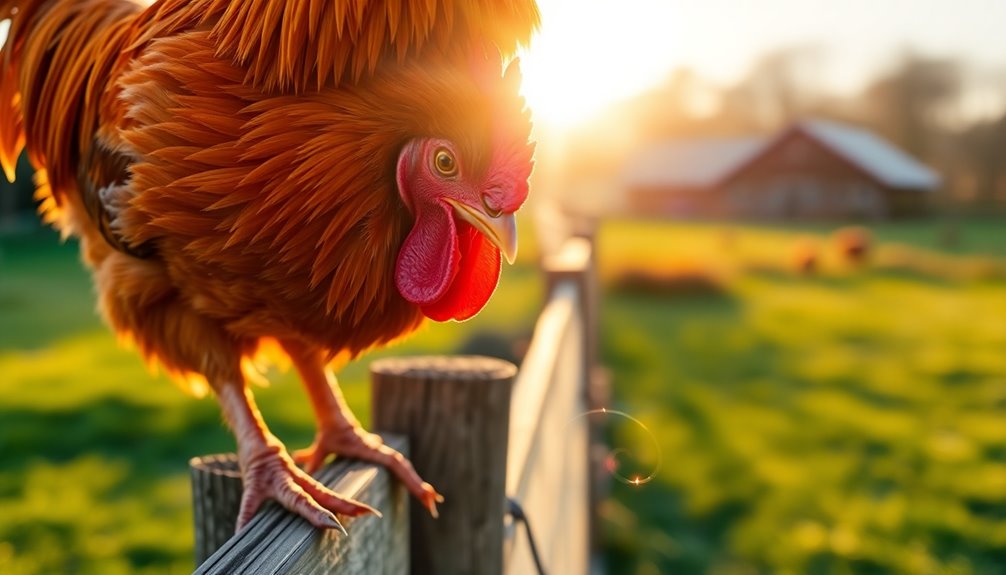To build effective windbreaks for outdoor animals, start by placing them on the upwind side of your animals, aligned perpendicular to prevailing winds. Use durable materials like wood, metal, or dense shrubs, and guarantee they are properly anchored for stability. Position them to block the strongest gusts and incorporate openings to prevent wind tunneling. Regular maintenance and adjustments will ensure long-lasting shelter, helping you create a safer, more comfortable environment for your animals. Keep exploring to learn how to optimize your windbreaks even further.
Key Takeaways
- Position windbreaks on the upwind side, perpendicular to prevailing winds, to maximize shelter for outdoor animals.
- Use durable, weather-resistant materials like dense shrubs, evergreen trees, or sturdy fencing aligned with seasonal wind patterns.
- Ensure proper construction with deep-set posts and reinforced joints for stability and longevity.
- Incorporate openings or gaps strategically to reduce wind pressure and prevent wind from sneaking through.
- Regularly inspect and maintain windbreaks to repair damage, reinforce supports, and adapt to changing wind conditions.
Choosing the Right Location for Windbreaks
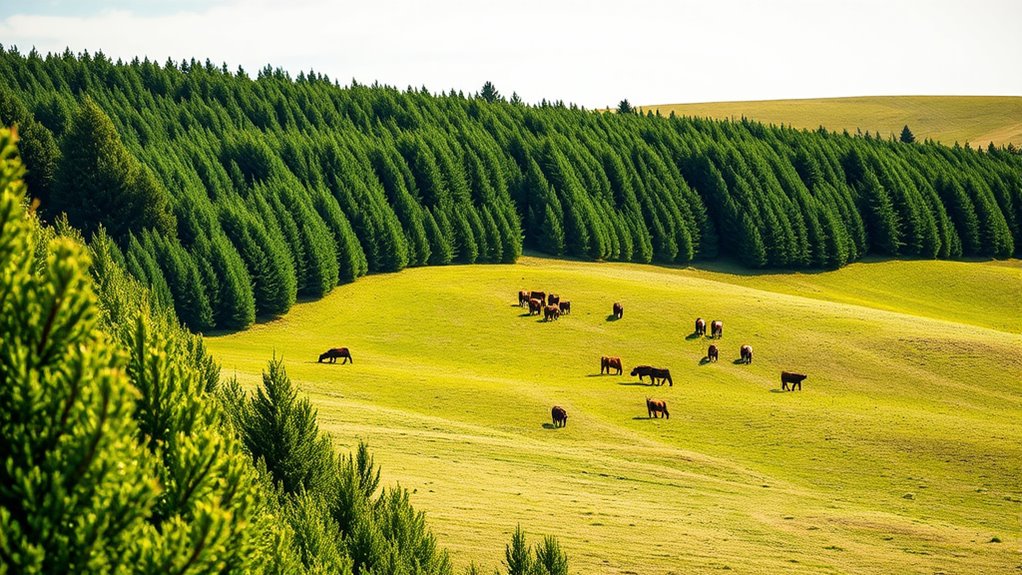
Choosing the right location for windbreaks is essential to maximize their effectiveness and protect your property. You want to place them where they block prevailing winds that cause the most damage or discomfort. Usually, this means positioning windbreaks on the upwind side of your outdoor animals, so the barrier intercepts the wind before it reaches them. Consider the direction and strength of local winds, and identify areas where strong gusts frequently occur. Avoid placing windbreaks near high-traffic zones or areas that could interfere with access or sunlight. You should also think about existing structures, trees, or natural features that can complement your windbreaks. Proper placement guarantees your windbreaks serve their purpose efficiently, providing shelter and reducing wind chill around your animals. Additionally, understanding the impact of cookies on user experience can help you design better online resources for your farm management.
Selecting Materials for Effective Barriers

What materials work best to create a durable and effective windbreak? You want sturdy, wind-resistant options that withstand weather and last long. Wood, especially tightly spaced slats or plywood, provides strength and acts as a solid barrier. Tall shrubs or dense evergreen trees are natural choices, offering both wind protection and visual screening. When choosing materials, consider durability, cost, and how well they block wind. Here’s a quick comparison:
| Material | Benefits |
|---|---|
| Wood | Strong, customizable |
| Dense Shrubs | Natural, aesthetic, wildlife-friendly |
| Metal Panels | Long-lasting, minimal maintenance |
Additionally, selecting materials with weather-resistant properties ensures the barrier remains effective over time.
Designing Windbreaks to Maximize Shelter
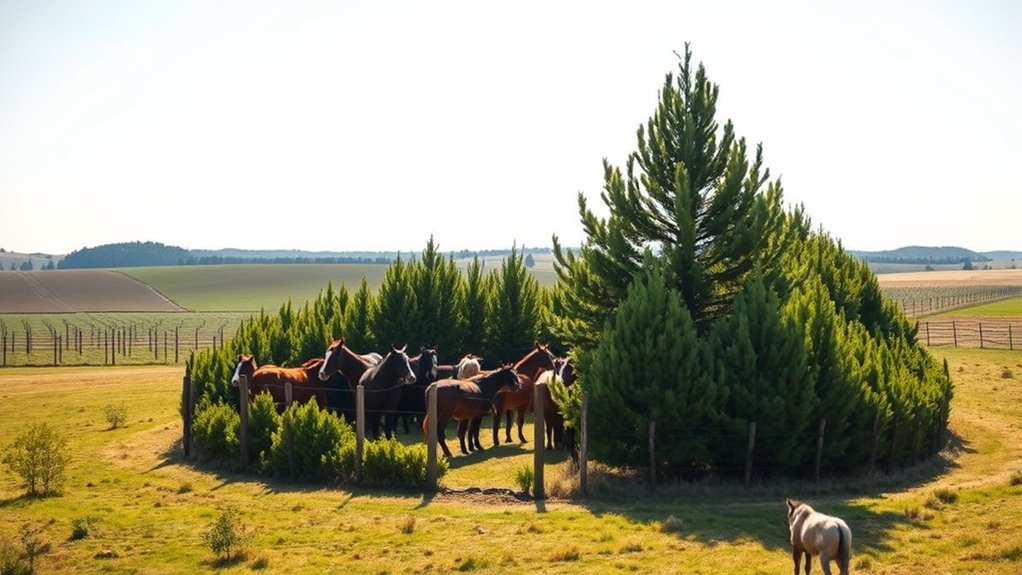
To maximize shelter, you need to carefully consider the windbreak‘s orientation so it blocks prevailing winds effectively. Choosing the right materials and structure will also enhance its durability and performance. By focusing on these strategies, you’ll create a more effective windbreak that offers better protection. Additionally, selecting appropriate plant species can further improve wind resistance and provide natural shelter.
Optimal Orientation Strategies
Have you ever wondered how to position a windbreak to provide the best shelter? The key is to align it perpendicular to prevailing winds. This orientation forces the wind to rise over the barrier, reducing airflow and creating a calmer area on the leeward side. For maximum protection, place the windbreak so it blocks the dominant wind direction year-round. If winds shift seasonally, consider flexible or adjustable designs. Keep in mind the landscape; natural features like hills or trees can influence wind patterns. Also, position openings or gaps strategically—ideally, small or minimal—to prevent wind from sneaking through. Proper orientation guarantees your windbreak effectively shields animals, minimizes stress, and promotes better health. Remember, thoughtful placement enhances shelter quality without unnecessary material use.
Material and Structure Choices
Choosing the right materials and structure is essential for creating an effective windbreak that provides maximum shelter. You want sturdy, durable materials like wood, shrubs, or fencing that can withstand harsh weather. Solid panels or closely spaced slats reduce wind flow effectively, while permeable materials allow some air circulation, preventing dampness. For the structure, consider height and width; taller windbreaks block more wind but shouldn’t be so tall they create turbulence. The shape matters too—straight barriers are effective, but angled or layered designs can improve wind deflection. Incorporate gaps at the top or bottom to allow airflow and prevent wind from swirling beneath. Effective contrast ratio in the design can help optimize visual clarity and wind resistance. Ultimately, your goal is to balance wind resistance with ventilation, creating a safe, comfortable environment for your outdoor animals.
Proper Construction Techniques for Durability

To build a durable windbreak, you need to choose sturdy materials that can withstand the elements. Make sure your structure is stable by following proper anchoring techniques and reinforcing key points. Proper construction guarantees your windbreak remains effective and resilient over time. Additionally, selecting materials resistant to weathering and corrosion can further enhance the longevity of your windbreak material durability.
Choosing Sturdy Materials
Selecting the right materials is essential for building windbreaks that last through harsh weather conditions. You need sturdy, weather-resistant options that can withstand wind, rain, and sun. Consider these four key materials:
- Pressure-treated wood – Durable and resistant to rot, perfect for framing and panels.
- Galvanized metal – Strong and long-lasting, ideal for support posts or reinforcement.
- Heavy-duty plastic or vinyl – Flexible and weatherproof, suitable for panels and fencing.
- Concrete or stone – Provides stability and durability for bases or foundations. Using materials with corrosion resistance ensures your windbreak remains effective over time. Prioritize quality and suitability for outdoor exposure to maximize longevity and protect your animals effectively.
Ensuring Structural Stability
Ensuring your windbreak remains stable requires applying proper construction techniques that prioritize strength and durability. Start by designing a solid framework that can withstand strong winds. Use thick, high-quality posts spaced appropriately to support the entire structure. Make sure the posts are deeply set into the ground, ideally at least one-third of their length, to prevent shifting. Use sturdy materials like treated wood or metal for the framing, avoiding weak or lightweight options. Reinforce joints with appropriate fasteners such as bolts or screws, not nails, to ensure they hold firmly over time. Maintain consistent spacing and alignment throughout the build to evenly distribute wind pressure. Regularly inspect your windbreak during construction to identify and correct any weak points, ensuring it can withstand the elements effectively. Additionally, understanding potential risks involved in construction can help mitigate future structural issues.
Proper Anchoring Techniques
Proper anchoring is essential to keep your windbreak stable and durable over time. Without it, strong winds can topple or damage your structure. To ensure secure anchoring, consider these techniques:
- Use heavy-duty stakes or anchors driven deep into the ground, at least 18 inches, for stability.
- Attach windbreak materials tightly with durable fasteners like galvanized nails or screws.
- Incorporate tension cables or guy wires to provide extra support against gusts.
- Regularly inspect and tighten all connections and anchors, especially after storms or high winds.
- Ensuring proper foundation stability is vital for the overall durability of your windbreak.
Positioning Windbreaks for Optimal Protection
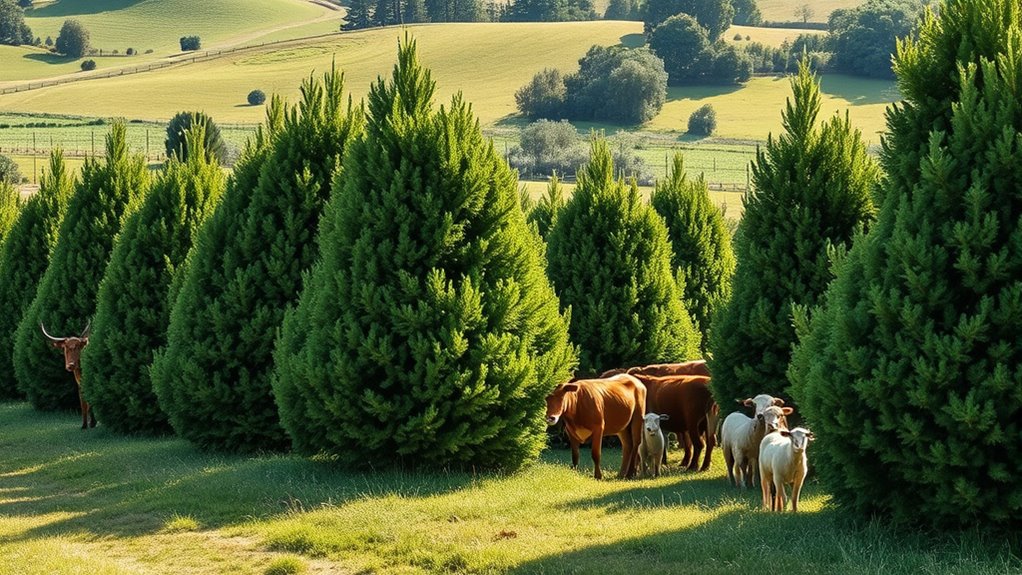
To achieve maximum protection, you need to carefully position your windbreaks in relation to the prevailing winds and your property layout. Identify the dominant wind direction during different seasons and place your windbreaks so they block these winds before they reach your animals. Position tall, dense plantings or fences on the windward side, typically the upwind edge, to intercept and slow the airflow. Ensure the windbreak extends beyond the area you want protected, creating a buffer zone that minimizes wind speed inside. Also, consider the shape and size of your property; placing windbreaks strategically along open borders or near vulnerable structures maximizes effectiveness. Proper placement reduces wind chill, protects animals from cold stress, and creates a more stable environment for outdoor livestock. Understanding wind patterns can help you optimize the placement further for year-round protection.
Maintaining and Adjusting Windbreaks Over Time
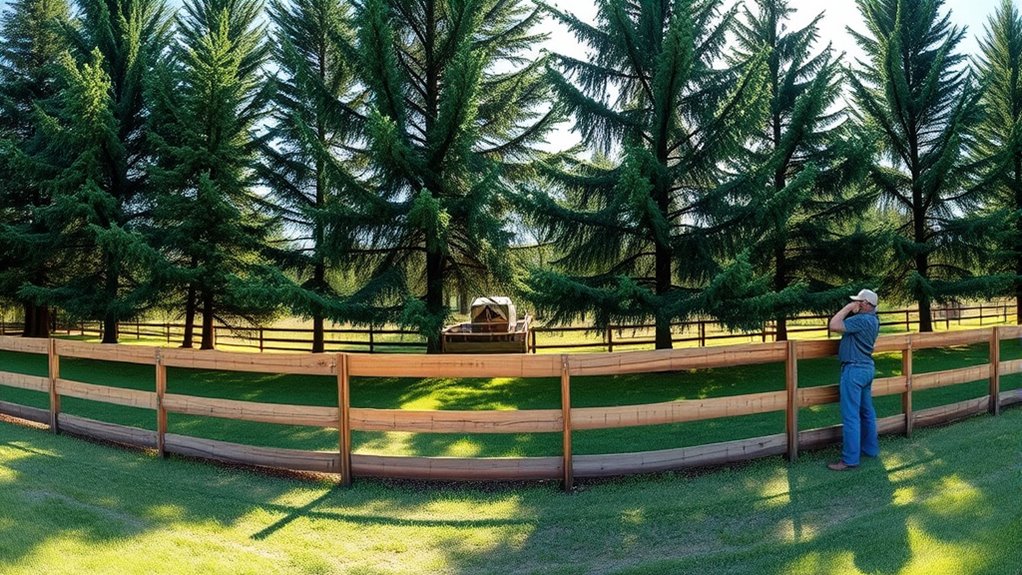
Regular maintenance and adjustments are essential to keep your windbreaks effective over time. You should regularly inspect for damage, such as broken branches or leaning sections. Address issues promptly to maintain protection. Consider these specific actions:
- Trim or replace damaged plants to ensure continuous wind resistance.
- Reinforce stakes or supports that may weaken with weather.
- Adjust the height or density if the wind patterns change or if animals grow.
- Clear debris or snow that can weigh down or harm your windbreak.
- Monitor the overall structure to ensure it remains sturdy and effective against changing environmental conditions to ensure longevity.
Additional Tips for Creating a Safe Environment
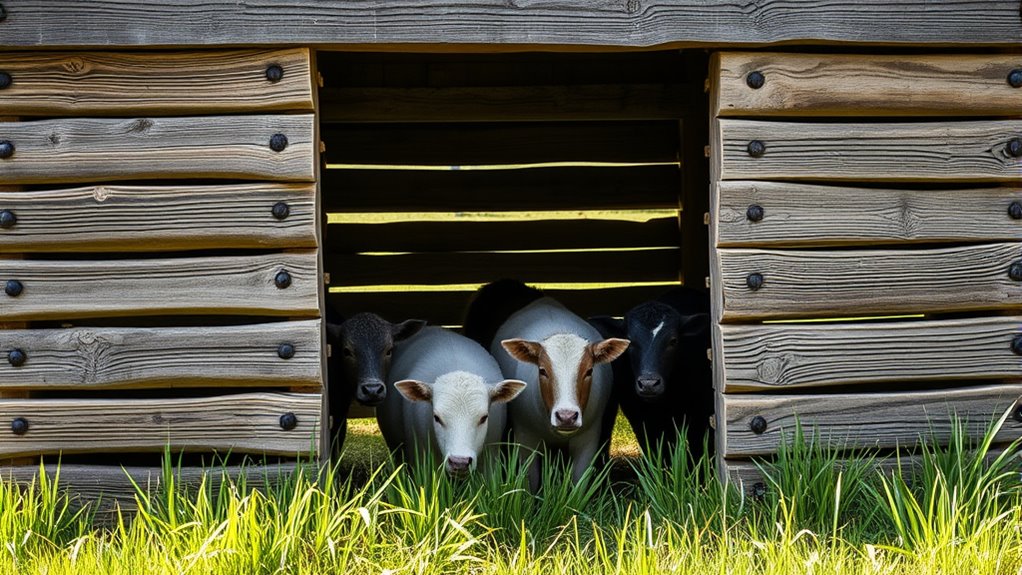
Creating a safe environment around your windbreak involves more than just planting trees; it requires thoughtful planning and ongoing vigilance. Make sure your windbreak is positioned away from busy roads and potential hazards to prevent accidents. Regularly inspect the area for fallen branches, debris, or signs of pest damage that could harm your animals. Keep paths clear and secure fencing nearby to restrict access to dangerous zones. Consider adding shelter within or near the windbreak so animals have a safe refuge during storms or extreme weather. Also, guarantee the windbreak doesn’t block essential sunlight or airflow, which can affect your animals’ health. Staying proactive and attentive helps maintain a safe, comfortable environment that protects your animals from environmental stressors.
Frequently Asked Questions
How Tall Should Windbreaks Be for Different Animal Species?
You should build windbreaks tall enough to block the prevailing winds for each animal species. For cattle and horses, aim for 6 to 8 feet high, while smaller animals like goats or sheep may only need 4 to 6 feet. Make sure the windbreaks are dense enough to reduce wind speed effectively. By customizing the height, you’ll provide better shelter, comfort, and protection from harsh weather conditions.
Can Windbreaks Be Combined With Other Shelter Types Effectively?
Absolutely, combining windbreaks with other shelter types creates a fortress for your animals against harsh weather. You can strategically place windbreaks near barns or run-ins, enhancing protection and comfort. This layered approach maximizes shelter efficiency, ensuring your animals stay warm and stress-free even during the fiercest storms. Think of it as building a nearly impenetrable shield—your animals will thank you for the extra care and safety.
What Are the Best Plant Options for Living Windbreaks?
You should consider planting evergreen trees like spruces, pines, or firs, as they provide year-round shelter and wind protection. Fast-growing deciduous species such as willow, poplar, or alder can also work well, especially if you want quick coverage in warmer months. Mix different species to create a resilient, effective windbreak that shields your outdoor animals from harsh winds while adding beauty to your landscape.
How Do Seasonal Changes Affect Windbreak Effectiveness?
As seasons shift, your windbreak’s effectiveness changes like a living shield. In winter, snow and ice can weigh down branches, reducing their barrier, while in summer, lush foliage dense the wind’s reach. You notice how leafless branches let gusts slip through, but full-grown greenery blocks harsh winds. To stay protected year-round, you’ll need to adapt by planting hardy, evergreen species that maintain their barrier through all seasons.
Are There Environmental Regulations Influencing Windbreak Construction?
Yes, environmental regulations can influence your windbreak construction. You might need permits or adhere to local, state, or federal rules that protect habitats, water quality, or endangered species. Regulations could also specify materials, height restrictions, or placement to minimize environmental impact. Check with your local authorities before starting, and verify your plans comply with all relevant laws to avoid fines or project delays.
Conclusion
By selecting the right location, choosing the best materials, designing thoughtfully, constructing with care, positioning strategically, and maintaining diligently, you create a safe haven for outdoor animals. You shield them from harsh winds, provide comfort in cold, and foster a secure environment in open spaces. With each step, you build a barrier of protection, a shield of safety, and a sanctuary of shelter—ensuring your animals thrive amid nature’s challenges.




